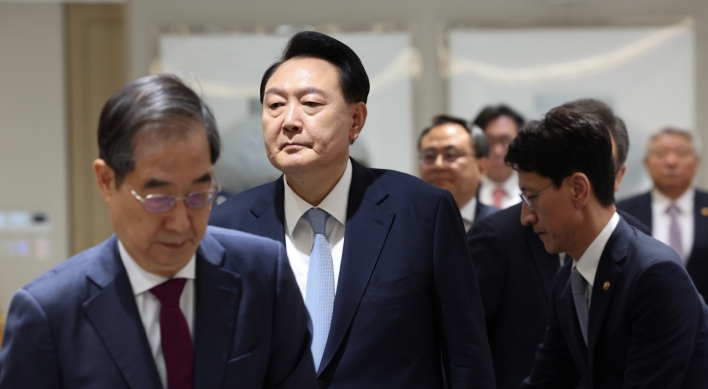[Heizo Takenaka] Third party role in moderating U.S.-China relations
By 류근하Published : March 9, 2011 - 18:03
TOKYO ― The closing decade of the 20th century offered a crystal ball for anyone peering into the future of the Asia-Pacific region. Japan’s economy, once the region’s leader, was “lost” after its asset bubble burst, whereas China overcame the economic stagnation that followed the Tiananmen Square crisis of 1989 to achieve its current path of strong growth. The debate raging 10 years ago about China’s rapid growth ― whether it represents a danger or an opportunity ― has now settled into broad agreement that wider regional development would be impossible without it.

Further geopolitical implications for the region and the world follow from three key changes in China. The first concerns the pattern of Chinese economic growth, which so far has been achieved mainly by rapid increases in factor inputs ― labor, capital, and energy. But recent research suggests that about one-third of China’s economic growth comes from technological progress, or from the increase in total factor productivity. In other words, China’s growth pattern is becoming similar to that of industrialized economies, suggesting that growth will be increasingly balanced.
The second transformation is the substantial appreciation of the renminbi that seems inevitable in the coming years. Today, given the importance of exports to China’s economy, its government is reluctant to permit a major revaluation, despite strong pressure by foreign governments to allow the renminbi to appreciate in line with the country’s huge trade surplus. But Chinese officials know that renminbi appreciation is also in China’s interest, as they seek to dampen inflationary pressures. China’s government therefore appears ready to allow the renminbi to appreciate, the question being how fast.
From 2003-05, long before the collapse of Lehman Brothers, the renminbi appreciated by 20 percent. In light of China’s rapid economic growth and the renminbi’s growing strength, Chinese GDP (based on the market dollar rate) will likely exceed that of the U.S. much earlier than expected, possibly in 10-15 years. And, when measured in terms of purchasing power parity, China’s GDP will reach that of the U.S. around 2015, thus changing the world’s balance of economic power.
The third transformation is demographic: the fallout from China’s official one-child policy, which will cause the working-age population to start declining in the mid-2010s. This will cause economic growth to slacken, complicating effective management of China’s domestic problems, which range from deep income disparities to the lack of political institutions capable of channeling popular grievances and demands.
In these circumstances, the role of the country’s political leadership will become much more important. Although the current president, Hu Jintao, is due to step down in 2012, he will continue to hold a degree of power through the military, so the succession of power to the next generation will not be completed until around 2015.
Although Chinese GDP is large and growing, its per capita income is still low, and its economic policies differ sharply from those prevailing in the region’s OECD countries. The geopolitical landscape that emerges around the middle of this decade will thus reflect significant changes elsewhere in Asia as well.
Even so, Chinese policy choices significantly influence other Asian countries, with China’s “state capitalist” economic model now being mimicked elsewhere in the region. Of course, Japan, Korea, and Singapore had similar policy models in the past (though they later adapted them in line with their GDP growth). Now, however, these countries are once again espousing forms of state capitalism and a return to industrial policy (encouraged as well by the 2008 global financial meltdown, which gave a new rationale for a return to government intervention).
In Japan, postal services that had been privatized are to be renationalized, and the role of government finance is being strengthened. Japan Air Lines, which was almost bankrupt, was rescued by a government bailout, a device that seems to be increasingly common. Similarly, while many Asian countries already have sovereign wealth funds, now South Korea’s government is establishing a new type of fund to support the construction sector’s export activities.
In short, closer business-government relationships are being reestablished throughout the Asian-Pacific region. Countries are especially seeking to strengthen their infrastructure exports through a combination of public- and private-sector activity. But that means that international regulations will be needed to limit government intervention, or at least to define the circumstances in which it will be deemed acceptable. To achieve this, the United States and China must reconcile their very different views of how a market economy should operate.
As the world begins to grapple with the creation of a new economic order, the moderating role of a third party in conflicts between the U.S. and China will be extremely important. It is a role that will fall to Japan for Asian-Pacific issues, but to European countries on global issues. If Europe can successfully manage this role, U.S.-China tensions can be overcome, offering the entire world the opportunity to harness and benefit from the strength of its two largest economies.
By Heizo Takenaka
Heizo Takenaka was minister of economics, minister of financial reform, and minister of internal affairs and communications under Prime Minister Junichiro Koizumi; he is currently director of the Global Security Research Institute at Keio University, Tokyo. ― Ed.
(Project Syndicate)

Further geopolitical implications for the region and the world follow from three key changes in China. The first concerns the pattern of Chinese economic growth, which so far has been achieved mainly by rapid increases in factor inputs ― labor, capital, and energy. But recent research suggests that about one-third of China’s economic growth comes from technological progress, or from the increase in total factor productivity. In other words, China’s growth pattern is becoming similar to that of industrialized economies, suggesting that growth will be increasingly balanced.
The second transformation is the substantial appreciation of the renminbi that seems inevitable in the coming years. Today, given the importance of exports to China’s economy, its government is reluctant to permit a major revaluation, despite strong pressure by foreign governments to allow the renminbi to appreciate in line with the country’s huge trade surplus. But Chinese officials know that renminbi appreciation is also in China’s interest, as they seek to dampen inflationary pressures. China’s government therefore appears ready to allow the renminbi to appreciate, the question being how fast.
From 2003-05, long before the collapse of Lehman Brothers, the renminbi appreciated by 20 percent. In light of China’s rapid economic growth and the renminbi’s growing strength, Chinese GDP (based on the market dollar rate) will likely exceed that of the U.S. much earlier than expected, possibly in 10-15 years. And, when measured in terms of purchasing power parity, China’s GDP will reach that of the U.S. around 2015, thus changing the world’s balance of economic power.
The third transformation is demographic: the fallout from China’s official one-child policy, which will cause the working-age population to start declining in the mid-2010s. This will cause economic growth to slacken, complicating effective management of China’s domestic problems, which range from deep income disparities to the lack of political institutions capable of channeling popular grievances and demands.
In these circumstances, the role of the country’s political leadership will become much more important. Although the current president, Hu Jintao, is due to step down in 2012, he will continue to hold a degree of power through the military, so the succession of power to the next generation will not be completed until around 2015.
Although Chinese GDP is large and growing, its per capita income is still low, and its economic policies differ sharply from those prevailing in the region’s OECD countries. The geopolitical landscape that emerges around the middle of this decade will thus reflect significant changes elsewhere in Asia as well.
Even so, Chinese policy choices significantly influence other Asian countries, with China’s “state capitalist” economic model now being mimicked elsewhere in the region. Of course, Japan, Korea, and Singapore had similar policy models in the past (though they later adapted them in line with their GDP growth). Now, however, these countries are once again espousing forms of state capitalism and a return to industrial policy (encouraged as well by the 2008 global financial meltdown, which gave a new rationale for a return to government intervention).
In Japan, postal services that had been privatized are to be renationalized, and the role of government finance is being strengthened. Japan Air Lines, which was almost bankrupt, was rescued by a government bailout, a device that seems to be increasingly common. Similarly, while many Asian countries already have sovereign wealth funds, now South Korea’s government is establishing a new type of fund to support the construction sector’s export activities.
In short, closer business-government relationships are being reestablished throughout the Asian-Pacific region. Countries are especially seeking to strengthen their infrastructure exports through a combination of public- and private-sector activity. But that means that international regulations will be needed to limit government intervention, or at least to define the circumstances in which it will be deemed acceptable. To achieve this, the United States and China must reconcile their very different views of how a market economy should operate.
As the world begins to grapple with the creation of a new economic order, the moderating role of a third party in conflicts between the U.S. and China will be extremely important. It is a role that will fall to Japan for Asian-Pacific issues, but to European countries on global issues. If Europe can successfully manage this role, U.S.-China tensions can be overcome, offering the entire world the opportunity to harness and benefit from the strength of its two largest economies.
By Heizo Takenaka
Heizo Takenaka was minister of economics, minister of financial reform, and minister of internal affairs and communications under Prime Minister Junichiro Koizumi; he is currently director of the Global Security Research Institute at Keio University, Tokyo. ― Ed.
(Project Syndicate)










![[KH Explains] How should Korea adjust its trade defenses against Chinese EVs?](http://res.heraldm.com/phpwas/restmb_idxmake.php?idx=644&simg=/content/image/2024/04/15/20240415050562_0.jpg&u=20240415144419)








